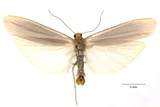Eilema caniola (Hübner, [1808]) Species
Last modified: Oct. 16, 2025, 6:24 p.m.
A fairly common species in the northern part of Belgium and not so common in the southern part.
This species is considered Least Concern according to the IUCN Red List category for Flanders 2023.
Details
- Classification
- Family: Erebidae > Subfamily: Arctiinae > Tribus: Lithosiini > Genus: Eilema > Species: Eilema caniola
- Vernacular names
- Vaal kokerbeertje (NL), Hoary footman (EN), Le Manteau pâle (FR), Weißgraues Flechtenbärchen (DE)
- First mention in Belgium
- Fologne E. 1859b. Supplément au catalogue des lépidoptères de Belgique. — Annales de la Société entomologique belge 3: 133–142. On page 133 (as Lithosia caniola. H.). view page
- Status
-
Native
Distribution
Bionomics
Hibernates as a larva and pupates in a cocoon under a stone or in a rock crevice. They come to light soon after dark and occasionally to sugar.
No pictures yet!
Flight periods
The adults fly usually in one, sometimes two generations a year from late June till late September, sometimes well into October.
Observed on
- Substrates:
- Lichens
The larva feeds on lichens and algae on rocks, but also reportedly on Lotus corniculatus and related plants.
No pictures yet!





